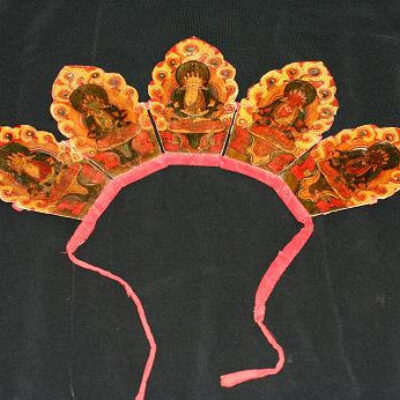
During the month of August, the Rosenberg Library exhibited a collection of Buddhist sacred objects made in Japan during the late 19th century. These items included an amulet, three vajras, a priest’s headdress, and three statues of Buddha. The artifacts were purchased by a Galveston businessman, Waters Davis, in 1890. That year, Davis made a trip around the world which included a visit to Japan. These Buddhist ritual objects were purchased at the Third National Industrial Exposition in Tokyo.

The Buddhist religion was founded by Siddharta Gautama, an Indian prince who lived during the 5th century B.C. According to tradition, Gautama left his wealthy family and sheltered life to seek enlightenment after he was exposed to the distress and suffering of others in the world. It wasn’t until he sat beneath a Bodhi tree and meditated for days that he achieved nirvana, or perfect peace of mind, and became the Buddha, or “enlightened one.” For the next 45 years, the Buddha devoted his life to teaching others to liberate themselves from suffering.
Guatama’s teachings were based on Four Noble Truths: life means suffering; the origin of suffering is attachment; the cessation of suffering is attainable; and the path to cessation is suffering. This gradual path of the Fourth Truth is described as the Eightfold Path.

It is the middle ground between excessive self-indulgence and excessive self-mortification. It leads to the cycle of re-birth, a continuous cycle over many lifetimes that ends only when nirvana is achieved.
One’s good or bad fortune in their subsequent reincarnations is based on the karma from their previous lives. Through the law of karma, the effects of all deeds actively create past, present, and future experiences. One is responsible for one’s own life and the pain or joy their actions bring to themselves and others.
Today, there are more than 360 million followers of the Buddhist religion. Although its birthplace was India, today, its practice there is virtually non-existent. Buddhism is prevalent throughout China, Japan, and Southeast Asia, and during the 20th century, its influence reached the West. There are various sects of the religion, but all of them share a reverence for figures of the Buddha and a common goal of ending suffering.
Of the collection of artifacts displayed at the Library, one of the most unusual is a Tibetan priest’s headdress, ca. 1890. It is made of five painted cardboard panels depicting five seated buddhas. Headpieces like this are worn by Tibetan lamas, or teachers, during special religious ceremonies or ritual dances. While wearing these headdresses, lamas visualize themselves as actual deities.
Another sacred artifact is a bronze amulet (or charm box) designed to attach to a belt or shoulder strap and be worn close to the body. It functions as a reliquary and contains the ashes of a Buddhist priest.
The exhibit included three beautifully gilded Buddha statues, all posed in standing positions. Each figure rests on a lotus, a plant which has a deep significance in the Buddhist religion. In nature, the roots of a lotus plant are embedded in mud underneath water, but its flower blooms above the water’s surface. This is symbolic of the Buddha living in a corrupt world but still maintaining his purity.

The hand gestures of the largest Buddha indicate its representation of reasoning and exposition. This mudra, or hand gesture, signifies the giving of instruction as well as an appeal for peace. Another Buddha is holding an alms bowl in his hands, while the third Buddha holds his hands in a prayer pose.
Also on exhibit were three brass vajras. Vajras are devotional objects used in Buddhist rituals in Tibet and Japan. The symbol of a thunderbolt, a vajra represents the ability of the Buddha’s teachings to pierce through ignorance and help one attain enlightenment. Two of the vajras have five spokes, meant to symbolize the five wisdoms: the mirror like wisdom, the wisdom of equality, the wisdom of individual analysis, the wisdom of accomplishing activity, and the sphere of reality. The third vajra, a double vajra in the shape of a cross, represents the stability and foundation of the physical world.